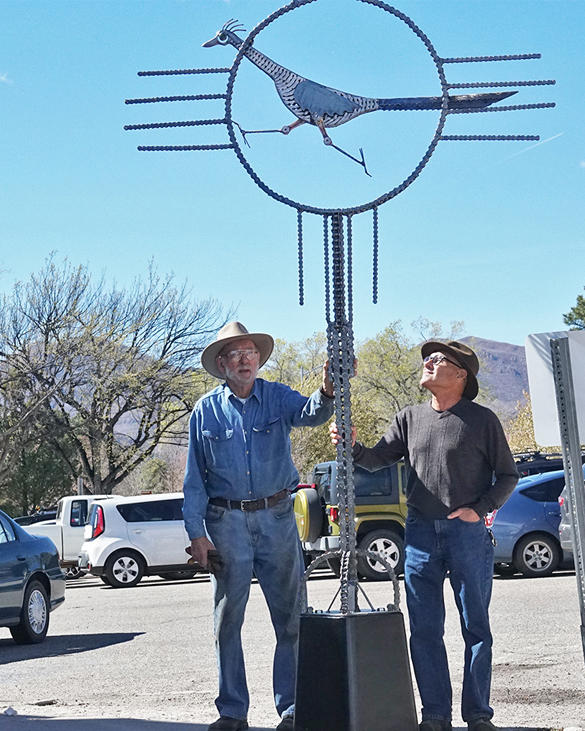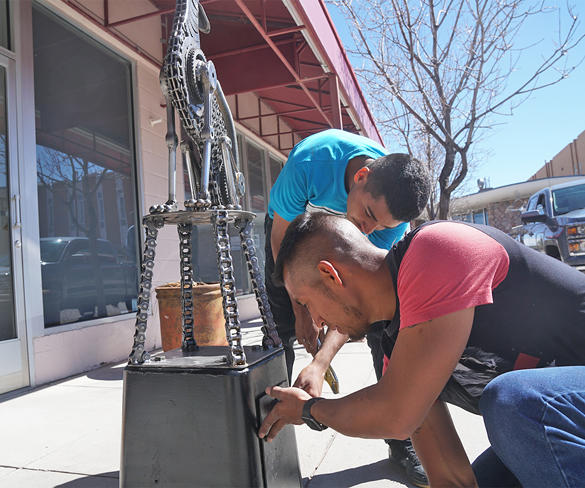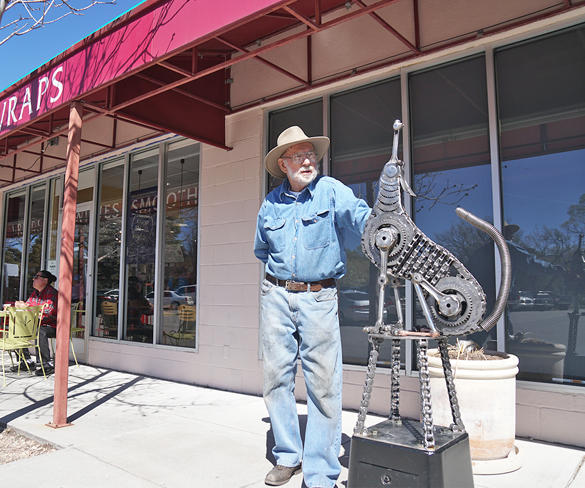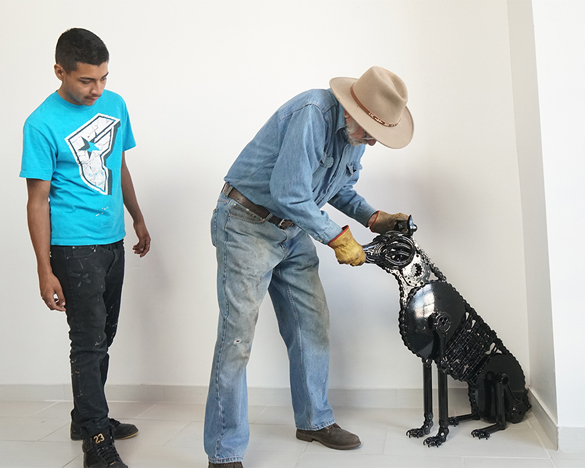 Artist Richard Swenson, left, and Central Park Square owner Philip Kunsberg check placement of the new Zia and Roadrunner sculpture near El Parasol in downtown Los Alamos. Photo by John McHale/ladailypost.com
Artist Richard Swenson, left, and Central Park Square owner Philip Kunsberg check placement of the new Zia and Roadrunner sculpture near El Parasol in downtown Los Alamos. Photo by John McHale/ladailypost.com
 Cesar Perez and Johnson Olivas put the finishing touches on the Howling Coyote sculpture installed in front of Ruby K’s on 20th Street and Central Avenue. Photo by John McHale/ladailypost.com
Cesar Perez and Johnson Olivas put the finishing touches on the Howling Coyote sculpture installed in front of Ruby K’s on 20th Street and Central Avenue. Photo by John McHale/ladailypost.com
 Local scrap metal artist Richard Swenson with his newly installed Howling Coyote sculpture at 20th and Central. Photo by John McHale/ladailypost.com
Local scrap metal artist Richard Swenson with his newly installed Howling Coyote sculpture at 20th and Central. Photo by John McHale/ladailypost.com
Three new sculptures by local scrap metal artist Richard Swenson were recently installed near 20th Street and Central Avenue.
Swenson has once again teamed up with Central Park Square owner Philip Kunsberg who also owns the buildings near the newly installed sculptures. Swenson’s Zia and Roadrunner sculpture stands tall near El Parasol, his Howling Coyote sits near Ruby K’s Bagel cafe and Max the Dog keeps a watchful eye on patrons entering the hallway outside of the Blue Window Bistro.
Kunsberg appreciates art and is a fan of Swenson’s work. Swenson has been a Minnesota farmer, Navy Seal, successful entrepreneur, civic leader, an accomplished physicist, inventor and now “an astonishing artist”, he said.
With the installation of Swenson’s latest sculptures, Kunsberg continues adding interest to downtown. Over the last couple of years, he has installed metal art pieces, created by Swenson, throughout Central Park Square including a large metal dinosaur visible on the right as one turns onto Main Street from Central Avenue, a black and red dragon sculpture resting in a planter area and a life-sized metal dog standing guard at the entrance to the Central Park Square administrative office near 15th and Nectar.
Central Park Square owner Philip Kunsberg told the Los Alamos Daily Post that Swenson has been a Minnesota farmer, a Navy Seal, an accomplished physicist, an inventor, a successful entrepreneur, a civic leader, and now “an astonishing artist.”
“In a short period of time, Richard has contributed greatly and diversely to the spirit of this place, he has said. “His witty, intelligent creations from scrap metal capture the mood and motion of living creatures. They make us aware of the amazing continuum of life on Earth, plus some creatures that exist only in our imaginations … they reveal what can be conjured up from what most of us would regard as junk. They embody surprising associations and transformations of ordinary shapes.
Swenson’s works also can be found perched on mailboxes, climbing up walls, inside the premises of many local businesses, at the Library and the Aquatic Center and at the new Los Alamos Nature Center.
“In my opinion, which is shared by many, we need to retain and value the retirees who contribute so immensely to the life of Los Alamos, and we should aspire to attract more like Richard Swenson.” Kunsberg said.
Swenson was born in 1934 on a ranch in the prairie of North Dakota. He was raised without electricity, running water or indoor conveniences. His was a culture of necessity and work was done with muscle – both man and animal, he said. Subsistence was based on animals, and he worked, befriended, fed, cared for, slaughtered, and ate animals, which he said fostered a reality most people in modern industrial society do not appreciate. He walked or rode a horse to his one-room country schoolhouse, attended an agricultural boarding school and followed with several years in the Navy Seal Team 11.
Earning advanced degrees in physics and mathematics resulted in a 30-year career in nuclear reactor physics and acoustic research in support of anti-submarine warfare.
“There was no association with art in any of these endeavors,” Swenson has said, adding that in 1977 he bought and operated a farm where he could revive and maintain his rapport with animals while still prospering in a high-tech science world. This world was a stark contrast to his origins, he said, adding, “It would be a lonesome place in this high-tech world without animals, for we are one of them.”
In 2000, Swenson began welding together miscellaneous scrap parts from his farm and restoration of his John Deer tractor collection. Swenson welded the parts into forms of the animals he grew up with, which has led to many exhibits of his work in places such as the Louisiana Art & Science Museum in Baton Rouge and the Longue Vue House & Gardens in New Orleans. His work can be found in public buildings, plazas and commercial facilities throughout New Mexico and Louisiana.
To learn more, click here.
 Ceasar Perez carries the Max the Dog sculpture to its new home in the hallway outside the Blue Window. Photo by John McHale/ladailypost.com
Ceasar Perez carries the Max the Dog sculpture to its new home in the hallway outside the Blue Window. Photo by John McHale/ladailypost.com
 Johnson Olivas, left, and Richard Swenson make the final adjustments on the Max the Dog sculpture. Photo by John McHale/ladailypost.com
Johnson Olivas, left, and Richard Swenson make the final adjustments on the Max the Dog sculpture. Photo by John McHale/ladailypost.com

